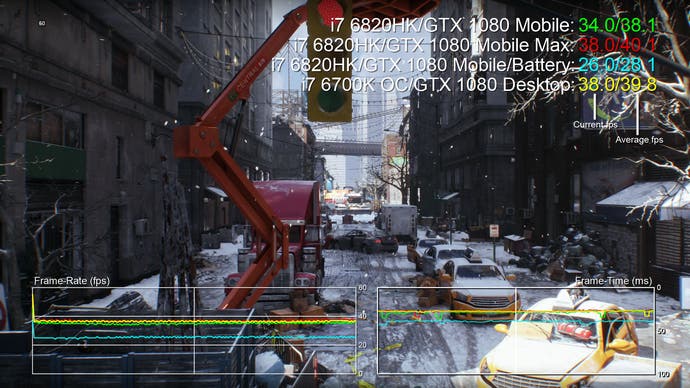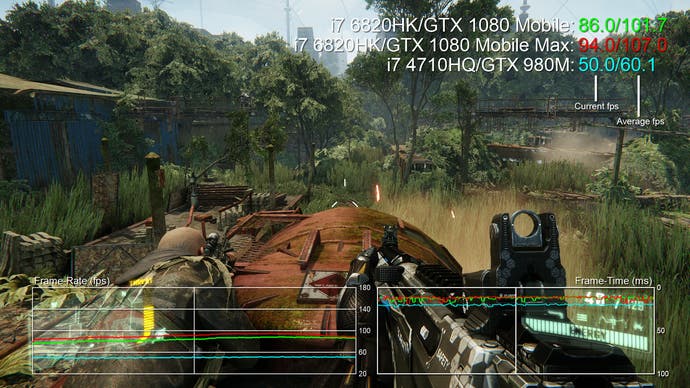Nvidia's Pascal-powered laptop chips are a true generational leap
Desktop GPU power finally comes to gaming notebooks. Digital Foundry goes hands-on.
Nvidia has lifted the lid on its new range of mobile GPUs based on the Pascal architecture - and the results are quite extraordinary. Gone are the days of laptop-specific graphics processors with reduced specs compared to their desktop counterparts. There is no GTX 1080M, only GTX 1080, with the same core specification as the desktop part: the same CUDA core count, the same boost clock. And it's the same for GTX 1060, too. Meanwhile, the mobile GTX 1070 does see some variation, trading boost clock speed for additional CUDA cores vs its desktop counterpart.
Nvidia reckons that its mobile processors are - at most - 10 per cent slower than then desktop equivalents, and that comes down to variations in the thermal solutions found in laptops, which will impact the kind of boost clocks you're likely to get in actual gaming scenarios. But even given what we would consider a constricted thermal envelope, the new Pascal-based mobile GPUs offer a huge leap in performance compared to their predecessors. There's even much-improved overclocking too - Nvidia demonstrated a 2.06GHz GTX 1080 overclock on an MSI notebook. Results will vary per implementation, but it's impressive nonetheless.
And there's another welcome innovation here: there's no downgrade to memory bandwidth as we saw with the likes of the old GTX 980M and its less capable siblings. GTX 1080 on laptops still ships with the same 10gbps GDDR5X memory, while GTX 1070 and GTX 1060 are still using top-of-the-line 8gbps GDDR5. So comparing specs, Nvidia's old GTX 980M flagship had just 160GB/s of memory bandwidth - GTX 1080 has double that: 320GB/s.
At a press event last week, journalists were given access to a range of laptops from virtually every major vendor, but the surprise package was a new Razer Blade 14, featuring a Core i7 quad-core processor backed by GTX 1060. It was playing host to Doom 2016, where it was running at 1080p on ultra settings at well over 60fps. It wasn't the most powerful laptop at the event - far from it - but it's first time that we've seen GPU power that comprehensively beats the current-gen consoles contained within a relatively small and thin laptop. The Razer Blade 14's form factor looked unchanged from existing models, which are comparable to a 13-inch Retina MacBook Pro.
| GTX 1080 Desktop | GTX 1080 Laptop | GTX 1070 Desktop | GTX 1070 Laptop | GTX 1060 Desktop | GTX 1060 Laptop | |
|---|---|---|---|---|---|---|
| CUDA Cores | 2560 | 2560 | 1920 | 2048 | 1280 | 1280 |
| Boost Clock | 1733MHz | 1733MHz | 1683MHz | 1645MHz | 1708MHz | 1670MHz |
| Memory | 8GB GDDR5X | 8GB GDDR5X | 8GB GDDR5 | 8GB GDDR5 | 6GB GDDR5 | 6GB GDDR5 |
| Memory Bandwidth | 320GB/s | 320GB/s | 256GB/s | 256GB/s | 192GB/s | 192GB/s |
For those put off by anaemic, smaller gaming laptops - and those not keen on 15 to 17-inch monsters, seeing this machine in action is something of a game-changer. GTX 1060 typically offers the ability to double console frame-rates while operating at a native 1080p - and to have that kind of power in an actual, portable laptop is highly compelling.
Nvidia's notebook Pascal offerings get even better - the new processors are paired with enhanced G-Sync displays. Up until now, we've been limited to 60Hz and 75Hz displays - but 120Hz offerings are en route, supporting 1080p resolution and with at least one 1440p equivalent in the offing too. On top of this, battery boost has been completely overhauled, eliminating the sub-optimal frame-time stutter we've previously noted. This is a software-level optimisation, so it also rolls out to previous mobile Nvidia GPU owners too - it's not Pascal-specific.
These are some lofty claims made by Nvidia in its notebook Pascal presentation, but we can offer some hands-on experience that corroborate the sales pitch, as we have the revised Asus GX800VH in the Digital Foundry office. Yes, that's the frankly insane desktop replacement with the strap-on watercooler - a machine that Asus believes to be the most powerful consumer laptop in the world, mostly by virtue of its twin GTX 1080s in SLI, which pair up quite nicely with a native 4K display.

| 3840x2160 (4K) | Core i7 6700K OC/ GTX 1080 Desktop | Core i7 6820HK/ GTX 1080 Laptop |
|---|---|---|
| Assassin's Creed Unity, Ultra High, FXAA | 32.9 | 31.1 |
| Ashes of the Singularity, Extreme, 0x MSAA, DX12 | 53.6 | 52.7 |
| Crysis 3, Very High, SMAA T2x | 39.6 | 37.3 |
| The Division, Ultra, SMAA | 38.5 | 38.5 |
| Far Cry Primal, Ultra, SMAA | 42.4 | 40.1 |
We'll be reviewing this in-depth soon, but we have some initial observations of the GTX 1080 specifically. For example, the Core i7 6820HK processor paired with one GPU (with the other disabled) tends to pull just 200-220W from the wall - a remarkable figure, in the same ballpark as the launch PlayStation 3 (!). However, we did note that The Division stands alone in exerting a higher load, taking us up to 260W. In terms of performance, the table above sees the desktop GTX 1080 feature a six to seven per cent advantage, so we assume that the boost clock calculation is somewhat different to its desktop equivalent.
In fact, boost clocks are actually around 100-150W down compared to the standard GTX 1080, but perhaps not surprisingly, parity is restored with the watercooler in place, and performance is entirely on par with the desktop model - not surprising as boost clocks are effectively identical here, topping out at 1866MHz, just like our Founders Edition board - and that's with Asus's auto-overclock disabled. In fact, with that cooler strapped on, both GPUs can hit and exceed desktop speeds. We actually ran one Division 4K benchmark after mistakenly removing the laptop from the mains - it was a happy accident actually, as it confirmed that Nvidia's power management from battery is vastly improved. Here, boost clocks dropped to the 1150MHz range - a meaty 500MHz drop, resulting in a 28 per cent drop in on-mains frame-rates. However, the game-breaking frame-time stutter previously seen when we tested a Maxwell-powered GTX 980M notebook is indeed absent.
While we couldn't match Nvidia's feat of overclocking the GTX 1080 to 2GHz on standard air cooling with the GX800VH, it's a whole different ballgame with the watercooler attached. We could run both of our mobile chips at 2GHz in SLI. On top of that, the G5X memory overclocked to 11.4gbps, compared to the stock 10gbps. Put simply, the Asus GX800VH is a fully viable - albeit large and heavy - 4K gaming machine.

It's the power efficiency figures that are tremendous bearing in mind the big, big leap in performance here. The GTX 1080 works in the same thermal envelope as the outgoing notebook-optimised GTX 980, while the mobile GTX 1070 - which should offer something very close to Maxwell Titan X performance - sits at the old GTX 980M's TDP. But it's the GTX 1060 that again grabs our attention here, as it's a drop-in replacement for the much less capable GTX 970M.
Nvidia's domination of the mobile notebook market is staggering, even eclipsing its desktop sales superiority. According to the firm's numbers, it has a 90-95 per cent market share. Some might say it's an unhealthy monopoly, but the bottom line is that with the move to 16nm FinFET process technology, Nvidia's already market-leading mobile line is taken to the next level with the new 10 series products.
While the mobile GTX 1080 takes centre-stage with its big, big leap in performance (it's anything up to 90 to 100 per cent faster than the GTX 980M based on our tests), it's actually the more lowly GTX 1060 that may well be most appealing - simply because it offers a sweet spot in terms of power consumption vs performance, opening up much more mobile-friendly form factors for gaming notebooks. Nvidia is already talking about gaming laptop market growth outstripping the current-gen consoles - and while there's obviously a yawning chasm in terms of price-points, the remarkable reality is a GTX 1060-equipped gaming laptop offers more GPU power than the upcoming PlayStation Neo. Now that's food for thought.










